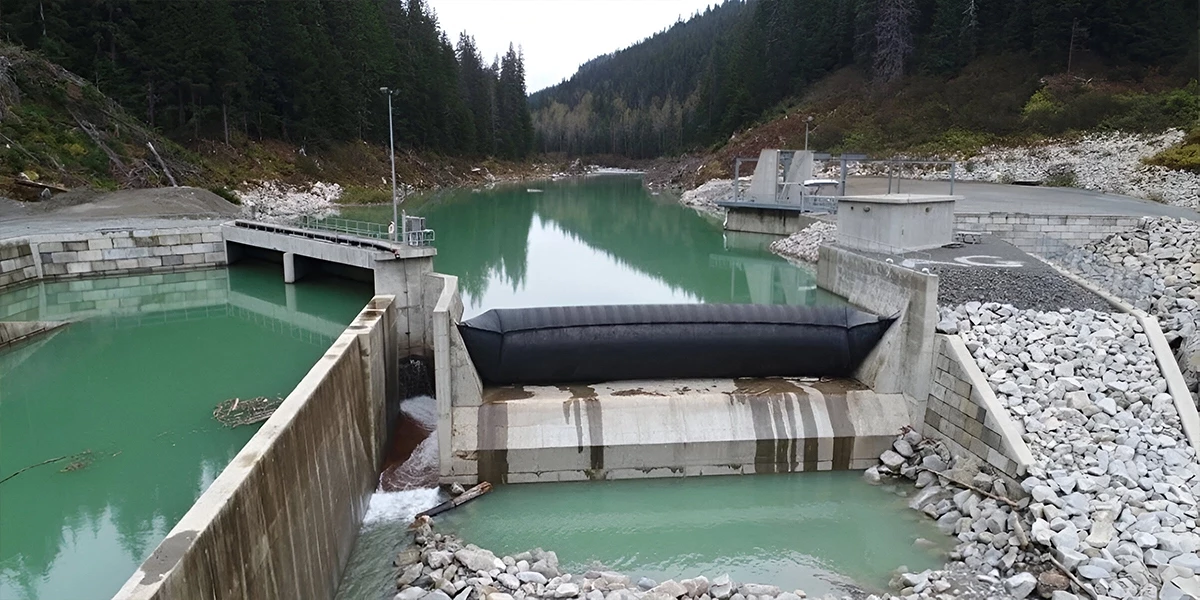

The diverse climate of India and its rising water management issues demand innovative solutions that would solve the problems of water scarcity, irrigation system needs, and flood control. The rubber dam operates as a sustainable water control structure because it delivers improved functionality compared to ordinary dams. Rubber dams are experiencing increasing popularity throughout India because they offer efficient solutions with flexible operation and economical advantages. Yooil Envirotech remains the leading company in the country in terms of building and deploying sustainable water management solutions through rubber dams.
Rubber dam in India function as flexible water flow regulation devices, which consist of synthetic rubber or reinforced fabric barriers that are installed across rivers and canals for control purposes. Water level control through rubber dams becomes possible because these structures differ from steel or concrete barriers, since operators can inflate or deflate them according to their needs. The constructed barrier structures serve multiple functions, including irrigation management and flood protection, groundwater sustainability, and hydropower generation capabilities.
The construction methods and operational principles of Rubber dams lead to different rubber dam types as follows:
Water movement remains restricted through this type of structure by filling the rubber bladder with compressed air. These systems weigh lightly yet need a regular air supply and constant checking.
The water-based pressure system makes rubber dams more durable by strengthening and protecting them against breakage and punctures. These dams offer optimal weight distribution and prove suitable for handling uneven surfaces during their intended use.
Rubber dams built with both air and water inflation systems provide better durability and operational flexibility.
The construction of rubber dams follows specific stages that result in operational efficiency alongside durability maintenance.
Site Assessment and Design: Engineers carry out extensive feasibility studies during the site assessment and design phases to select the best positioning and design parameters for the dam.
Foundation Preparation: The foundation is prepared by building concrete or steel components that securely anchor the rubber bladder.
Installation of Rubber Bladder: Anchoring systems secure the rubber membrane when it is spread and installed on the foundation.
Inflation Mechanism Setup: The air or water inflation procedure functions through an installed system to enable automated deflation and expansion of the structure.
Testing and Commissioning: Tests under different environmental circumstances follow the commissioning process to verify proper operation.
Rubber dam advantages provide several superior capabilities when compared to standard water management systems.
Cost-Effective: The initial expenditure and maintenance expenses for rubber dams remain lower than those of conventional dams.
Eco-Friendly: The water management structures possess two attractive environmental benefits: they enable fish to swim uninterrupted and maintain free sediment transport, preserving the ecosystem.
Flexible and Adjustable: These water structures possess adjustable and flexible characteristics due to their inflation-deflation capabilities for water use.
Quick Installation: The process of installing rubber dams takes only weeks to complete, while constructing concrete dams requires multiple years.
Durability: Modern rubber components demonstrate great resistance to UV radiation and chemical exposure and can withstand extreme weather elements.
Energy Efficiency: These rubber components enable power production through renewable energy generation in hydropower projects without harming the environment.
By serving paramount functions in supporting different rubber dam water management operations.
Irrigation Control: Water regulators enable farmers to manage irrigation reservoirs properly, thus obtaining sufficient dry-season water supplies.
Flood Mitigation: Rubber dams prevent flooding by managing the flow of water in both rural and urban areas.
Groundwater Recharge: The prolonged water retention capacity of rubber dams allows natural groundwater replenishment to occur.
Hydropower Generation: Hydropower generation is made possible thanks to dam structures, which enable the development of small-scale renewable energy plants.
Urban Water Supply: Rubber dams enable urban centers to maximally store and effectively regulate their drinking water resources.
The nation has started the construction of multiple rubber dam infrastructure projects to boost its water management systems. The construction of the longest rubber dam in India stands as a significant achievement for Indian innovation in advanced water conservation practices. These projects prove rubber dams represent an effective method for sustainable water resource management.
Yooil Envirotech is a pioneer in implementing advanced rubber dam solutions in India. The company specializes in designing, constructing, and maintaining rubber dams tailored to India's diverse geographic and climatic conditions. With expertise in sustainable water management, Yooil Envirotech ensures that its rubber dams are technologically advanced and environmentally friendly.
River Water Conservation Initiatives: Yooil Envirotech has installed rubber dams across key rivers to enhance water conservation efforts.
Smart Flood Control Systems: The company integrates IoT and AI-based monitoring systems to optimize flood management using rubber dams.
Agricultural Water Management: Rubber dams installed by Yooil Envirotech provide reliable irrigation solutions for farmers across India.
Hydropower Integration: The firm collaborates with renewable energy providers to develop rubber dam-based hydropower projects.
As India faces water scarcity and climate change challenges, rubber dams will play an increasingly vital role in sustainable water management. Innovations in rubber dam construction technology, combined with IoT-enabled water management systems, will enhance the efficiency and effectiveness of these dams. Government initiatives and public-private partnerships will further accelerate the adoption of rubber dams nationwide.
The rubber dam in India represents a transformative approach to water management. Their flexibility, cost-effectiveness, and sustainability make them an ideal solution for addressing India’s water conservation challenges. With Yooil Envirotech leading the way in rubber dam construction and innovation, India is well-positioned to harness the full potential of this advanced technology. Investing in rubber dam solutions today will ensure a water-secure future for generations.
